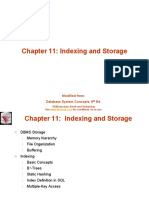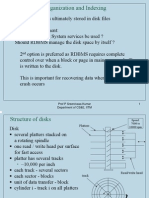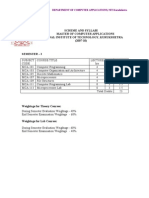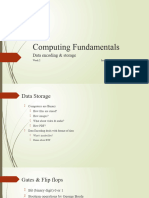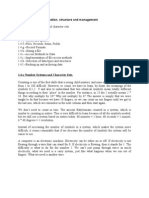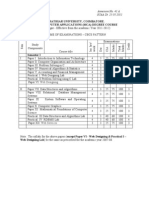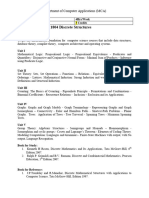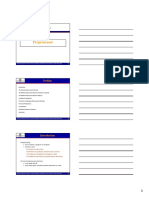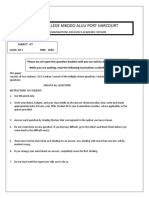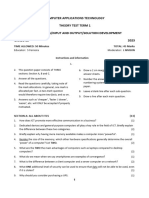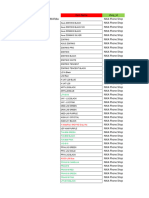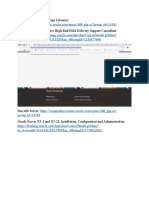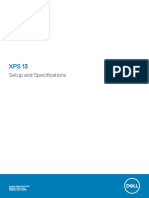4/11/2015MCA-102, Data and File Structures
DATA STRUCTURE
FILES
UNIT IV
Bharati Vidyapeeths Institute of Computer Applications and Management, New Delhi-63, by Shalini Singh
U4.1
Learning Objectives
Files
Sequential File Organization
Buffering
Buffering
Handling Sequential Files in C
External Sorting
Bharati Vidyapeeths Institute of Computer Applications and Management, New Delhi-63, by Shalini Singh
U4.2
Sequential File Organization
ISAM is the most popular sequential file organization
Cylinder surface index is maintained for primary key.
Makes search based on PK efficient
Search based on other attributes require use of an alternate
indexing technique
Insertion, Deletion are time consuming
Batch processes and Range queries are executed efficiently
Bharati Vidyapeeths Institute of Computer Applications and Management, New Delhi-63, by Shalini Singh
U4.3
Bharati Vidyapeeths Institute of Computer Applications and Management, New Delhi-63, by Shalini Singh
U4.1
�4/11/2015MCA-102, Data and File Structures
Sequential Files
Sequential files are files where the order of the records in
the file is based on the order the records are placed in the
file (that is, in arrival sequence)
The order of the records is fixed.
R
Records
d in
i these
th
fil
files
can only
l be
b read
d or written
itt
sequentially i.e. to read Nth record we must first access N-1
records.
Bharati Vidyapeeths Institute of Computer Applications and Management, New Delhi-63, by Shalini Singh
U4.4
Sequential File Organization
Bharati Vidyapeeths Institute of Computer Applications and Management, New Delhi-63, by Shalini Singh
U4.5
Sequential Files
One common storage medium used for sequential files is
Magnetic Tape.
Here data is recorded digitally as magnetized spots in the
film coating.
Positive magnetization may represent 1-bit and negative
magnetization may represent a 0-bit or vice-versa.
The magnetized areas are not randomly located on the
medium but are arranged in tracks parallel to the edge of the
tape.
Bharati Vidyapeeths Institute of Computer Applications and Management, New Delhi-63, by Shalini Singh
U4.6
Bharati Vidyapeeths Institute of Computer Applications and Management, New Delhi-63, by Shalini Singh
U4.2
�4/11/2015MCA-102, Data and File Structures
Data Density
There are usually nine tracks on a tape. Eight of
them record data and the ninth records error control
bits.
Density is measured in units of bits per inch (bpi).
Density is a function of both the tape medium and
the drive used to record onto the medium.
Bharati Vidyapeeths Institute of Computer Applications and Management, New Delhi-63, by Shalini Singh
U4.7
Advantages
Simple file design
Easy to process
Very efficient when most of the records must be processed
e g Payroll
e.g.
Can be easily shared with other applications developed
using different programming languages.
Can be stored on inexpensive devices like magnetic tape.
Bharati Vidyapeeths Institute of Computer Applications and Management, New Delhi-63, by Shalini Singh
U4.8
Disadvantages
Can be only processed sequentially.
If you need to read record number N, you must first read
the previous N-1 records
Insertion of new record at position i involves moving all
records from i-n to a temp file and after insertion well have
to append the temp file with the original file.
Entire file must be processed even if a single record is to be
searched.
Especially no good for programs that make frequent
searches in the file
Overall processing is slow
Bharati Vidyapeeths Institute of Computer Applications and Management, New Delhi-63, by Shalini Singh
U4.9
Bharati Vidyapeeths Institute of Computer Applications and Management, New Delhi-63, by Shalini Singh
U4.3
�4/11/2015MCA-102, Data and File Structures
Data Representation
This is how .byte 11 (in MIPS) is stores in memory:
0000 0000 0000 0000 0000 0000 0000 1011
Big Endian:
Little Endian:
0000 0000
0000 1011
0000 0000
0000 0000
0000 0000
0000 0000
0000 1011
0000 0000
(e.g. Intel)
(e.g. SPARC)
Bharati Vidyapeeths Institute of Computer Applications and Management, New Delhi-63, by Shalini Singh
U4.10
Data Representation
We need a way to map: data -> binary
Data Types:
Number
Integer
g
Signed/Unsigned
Real
Char
Other (Picture, etc.)
Bharati Vidyapeeths Institute of Computer Applications and Management, New Delhi-63, by Shalini Singh
U4.11
Data Representation: Integer
Integers:
A decimal example: 2734 =
2 * 103 + 7 * 102 + 3 * 101 + 4 * 100
A binary example: [01011]2 =
0 * 24 + 1 * 23 + 0 * 22 + 1 * 21 + 1 * 20 = [11] 10
Bharati Vidyapeeths Institute of Computer Applications and Management, New Delhi-63, by Shalini Singh
U4.12
Bharati Vidyapeeths Institute of Computer Applications and Management, New Delhi-63, by Shalini Singh
U4.4
�4/11/2015MCA-102, Data and File Structures
Data Representation: Unsigned
Unsigned
Unsigned integers are positive (or to be more precise, do not
have a sign).
Size
Limit (low, high)
8 bits 0,
0 255 (255 = 28 - 1)
16 bits
0, 64k (64k = 216 - 1)
N bits 0, 2N 1
Signed
Represented in 2s complement form
Bharati Vidyapeeths Institute of Computer Applications and Management, New Delhi-63, by Shalini Singh
U4.13
Data Representation: Real Nos.
Real Numbers
There are many standards to represent real numbers. E.g. the IEEE 754
standard.
Sign
8-bits
Exponent
23-bits
Mantissa
Bharati Vidyapeeths Institute of Computer Applications and Management, New Delhi-63, by Shalini Singh
U4.14
Data Representation: Real
The first bit is the sign,
The next 8-bit portion is the Biased Exponent (the exponent
of 2 plus 127 to ensure we get a positive number)
The last 23-bit p
portion is Mantisa.
Note that there are 224 digits in the fraction part (including
the 1 normalized form that is not stored in memory) which
represents 6 digits.
This is the number of significant figures in a floating point number.
Most CPUs have 6-7 significant figures
Bharati Vidyapeeths Institute of Computer Applications and Management, New Delhi-63, by Shalini Singh
U4.15
Bharati Vidyapeeths Institute of Computer Applications and Management, New Delhi-63, by Shalini Singh
U4.5
�4/11/2015MCA-102, Data and File Structures
Data Representation
Characters
We use a mapping system to convert between ASCII
characters (or other coding scheme)
and their value that is stored in memory as an 8 bit (or
the number of bits required by the scheme) unsigned
integer.
g
Other Data
Other types of data can include pictures, video, sound
etc.
Different standards govern the storage mechanism for
this kind of data.
Bharati Vidyapeeths Institute of Computer Applications and Management, New Delhi-63, by Shalini Singh
U4.16
Parity Checking
Simple or Two Dimensional
In parity check, a parity bit is added to every data unit so
that the total number of 1s is even or odd.
Bharati Vidyapeeths Institute of Computer Applications and Management, New Delhi-63, by Shalini Singh
U4.17
Parity Checking
Bharati Vidyapeeths Institute of Computer Applications and Management, New Delhi-63, by Shalini Singh
U4.18
Bharati Vidyapeeths Institute of Computer Applications and Management, New Delhi-63, by Shalini Singh
U4.6
�4/11/2015MCA-102, Data and File Structures
Parity Checking
Suppose the sender wants to send the word world. In ASCII
the five characters are coded as
1110111 1101111 1110010 1101100 1100100
The following shows the actual bits sent
11101110 11011110 11100100 11011000 11001001
Bharati Vidyapeeths Institute of Computer Applications and Management, New Delhi-63, by Shalini Singh
U4.19
Parity Checking
Two-dimensional parity
In two-dimensional parity check, a block of bits is divided
into rows and a redundant row of bits is added to the
whole block.
Bharati Vidyapeeths Institute of Computer Applications and Management, New Delhi-63, by Shalini Singh
U4.20
2D Parity Checking
Bharati Vidyapeeths Institute of Computer Applications and Management, New Delhi-63, by Shalini Singh
U4.21
Bharati Vidyapeeths Institute of Computer Applications and Management, New Delhi-63, by Shalini Singh
U4.7
�4/11/2015MCA-102, Data and File Structures
Other Techniques
Other techniques for error control include:
Arithmetic Checksums
CRC Checks
Bharati Vidyapeeths Institute of Computer Applications and Management, New Delhi-63, by Shalini Singh
U4.22
Blocks
Data are read or written to a tape in groups of characters
called blocks.
A block is the smallest amount of data that can be
transferred between secondary memory and primary
memory in one access.
A block may contain one or more records.
A block is sometimes referred to as a physical record.
Between each pair of blocks, there is a space or gap termed
as interblock gap.
Bharati Vidyapeeths Institute of Computer Applications and Management, New Delhi-63, by Shalini Singh
U4.23
Buffer
A buffer is a region of a physical memory storage used to
temporarily hold data while it is being moved from one place to
another.
Typically, the data is stored in a buffer as it is retrieved from an
input device or just before it is sent to an output device.
A buffer may also be used when moving data between processes
within a computer.
Bharati Vidyapeeths Institute of Computer Applications and Management, New Delhi-63, by Shalini Singh
U4.24
Bharati Vidyapeeths Institute of Computer Applications and Management, New Delhi-63, by Shalini Singh
U4.8
�4/11/2015MCA-102, Data and File Structures
Buffering
Three kinds of buffering are supported: line-buffering, blockbuffering or no-buffering.
For output, items are written out from the internal buffer according
to the buffer mode:
line-buffering: the entire buffer is written out whenever a newline
is output, the buffer overflows, a flush is issued, or the handle is
closed.
block-buffering: the entire buffer is written out whenever it
overflows, a flush is issued, or the handle is closed.
no-buffering: output is written immediately, and never stored in
the buffer.
Bharati Vidyapeeths Institute of Computer Applications and Management, New Delhi-63, by Shalini Singh
U4.25
Buffering
Multiple buffering
is the use of more than one buffer to hold a block of data,
so that a "reader" will see a complete (though perhaps old)
version of the data,
rather than a partially updated version of the data being
created by a writer.
Double Buffering
A programming technique that uses two buffers to speed up a
computer that can overlap I/O with processing.
Data in one buffer is being processed while the next set of
data is read into the other one.
Bharati Vidyapeeths Institute of Computer Applications and Management, New Delhi-63, by Shalini Singh
U4.26
Creation of Files
Files are created through fopen()
with w or w+ modes
FILE*fopen(constchar*filename
FILE
fopen(constchar filename,constchar
constchar*mode)
mode)
Further set of permissible operations are decided on
basis of file open mode
Bharati Vidyapeeths Institute of Computer Applications and Management, New Delhi-63, by Shalini Singh
U4.27
Bharati Vidyapeeths Institute of Computer Applications and Management, New Delhi-63, by Shalini Singh
U4.9
�4/11/2015MCA-102, Data and File Structures
File Open Modes
Mode
Operations
Allowed
Action
Read
Return NULL if file doesnt exist
Write
Create if file doesnt exist.
Destroy file contents if it exists
Write at end
Create if file doesn
doesntt exist.
exist
Retain old contents
r+
Read Write
Return NULL if file doesnt exist
w+
Read Write
Create if file doesnt exist.
Destroy file contents if it exists
a+
Read,
Write-at-end
Create if file doesnt exist.
Retain old contents
Bharati Vidyapeeths Institute of Computer Applications and Management, New Delhi-63, by Shalini Singh
U4.28
Insertion in Files
Writing of new records will be done in a sequential
manner at the end of the file.
Contentinitiallystoredwillbe
overwritten
Ifwewanttoinsertanewrecordatith
positionthenwellhavetocopyall
records(in)toatemporaryfile.
Bharati Vidyapeeths Institute of Computer Applications and Management, New Delhi-63, by Shalini Singh
U4.29
Functions for Reading from a File
intfgetc(FILE
*stream)
intfgets(char s,intn,FILE
intfgets(char*s,intn,FILE
*stream)
intfscanf(FILE*stream,constchar*format,...)
size_tfread(constvoid*ptr,size_tsize,size_tnobj,FILE*stream)
Bharati Vidyapeeths Institute of Computer Applications and Management, New Delhi-63, by Shalini Singh
U4.30
Bharati Vidyapeeths Institute of Computer Applications and Management, New Delhi-63, by Shalini Singh
U4.10
�4/11/2015MCA-102, Data and File Structures
Functions for Writing to a File
intfputc(intc,FILE*stream)
intfputs(constchar*s,FILE*stream)
intfputs(constchar
s,FILE stream)
intfprintf(FILE*stream,constchar*format,...)
size_tfwrite(constvoid*ptr,size_tsize,size_tnobj,FILE*stream)
Bharati Vidyapeeths Institute of Computer Applications and Management, New Delhi-63, by Shalini Singh
U4.31
Repositioning the Read-Write Locator
Repositions the file pointer on a stream:
int fseek (FILE* fp, long offset, int origin);
offset is the number of bytes to move the position indicator
origin says where to move from
Three options/constants are defined for origin
SEEK_SET
move the indicator offset bytes from the beginning
SEEK_CUR
move the indicator offset bytes from its current position
SEEK_END
move the indicator offset bytes from the end
Bharati Vidyapeeths Institute of Computer Applications and Management, New Delhi-63, by Shalini Singh
U4.32
Retrieve the Position of Read Write Locator
long ftell (FILE * fp) ;
Returns the current value of the file position indicator,
i.e. the number of bytes from the start of the file (starts
at zero)
To determine where the position indicator is use:
long pos= ftell (fp) ;
Returns a long giving the current position in bytes.
The first byte of the file is byte 0.
If an error occurs, ftell () returns -1.
Bharati Vidyapeeths Institute of Computer Applications and Management, New Delhi-63, by Shalini Singh
U4.33
Bharati Vidyapeeths Institute of Computer Applications and Management, New Delhi-63, by Shalini Singh
U4.11
�4/11/2015MCA-102, Data and File Structures
Closing and Deleting a File
intfclose(FILE*stream)
fclose flushes any unwritten data for stream, discards any
unread buffered input, frees any automatically allocated
buffer, then closes the stream.
It returns EOF if any errors occurred,
occurred and zero otherwise
otherwise.
intremove(constchar*filename)
remove removes the named file, so that a subsequent
attempt to open it will fail.
It returns non-zero if the attempt fails.
Bharati Vidyapeeths Institute of Computer Applications and Management, New Delhi-63, by Shalini Singh
U4.34
What we Studied
Sequential Files
Advantages & Disadvantages
Handling Sequential Files in C
Bharati Vidyapeeths Institute of Computer Applications and Management, New Delhi-63, by Shalini Singh
U4.35
EXTERNAL SORTING
Bharati Vidyapeeths Institute of Computer Applications and Management, New Delhi-63, by Shalini Singh
U4.36
Bharati Vidyapeeths Institute of Computer Applications and Management, New Delhi-63, by Shalini Singh
U4.12
�4/11/2015MCA-102, Data and File Structures
Objectives
External Sorting Techniques
K-way Merge Sort
Balanced Merge Sort with 2*K Tapes
Balanced Merge Sort with K+1
Tapes
Poly-Phase Merge Sort
Bharati Vidyapeeths Institute of Computer Applications and Management, New Delhi-63, by Shalini Singh
U4.37
External Sorting
Need
Entire data to be sorted might not fit in the available
internal memory
Considerations
When data resides in internal memory
Data access time << Computation time
Need to reduce the number of CPU operations
When data resides on external storage devices
Data access time >> Computation time
Need to reduce disk accesses
Bharati Vidyapeeths Institute of Computer Applications and Management, New Delhi-63, by Shalini Singh
U4.38
Algorithms
Merge sort
Multi-way / k-way merge sort
Balanced
Poly-phase
Bharati Vidyapeeths Institute of Computer Applications and Management, New Delhi-63, by Shalini Singh
U4.39
Bharati Vidyapeeths Institute of Computer Applications and Management, New Delhi-63, by Shalini Singh
U4.13
�4/11/2015MCA-102, Data and File Structures
General Approach
Divide data into smaller segments that can fit into internal
memory
Sort them internally
g
((called runs)) to secondaryy
Write the sorted segments
storage
Merge the runs together to get runs of larger size
Continue until a single run is left
Bharati Vidyapeeths Institute of Computer Applications and Management, New Delhi-63, by Shalini Singh
U4.40
Contd...
Assumptions
There are N records on the disk
It is possible to sort M records using internal sort
(at a time)
Bharati Vidyapeeths Institute of Computer Applications and Management, New Delhi-63, by Shalini Singh
U4.41
External- Merge Sort
Sort process
Create N/M sorted runs, reading M records at a time
Set aside 3 blocks of internal memory each capable of
holding M/3 records
First two blocks act as input buffers
Third acts as output buffer
Merge runs {R1, R2}; {R3, R4} to get N/2M runs of size
2M each
Continue merging till a single run of size N is not
obtained
Also called 2-way merge sort
Bharati Vidyapeeths Institute of Computer Applications and Management, New Delhi-63, by Shalini Singh
U4.42
Bharati Vidyapeeths Institute of Computer Applications and Management, New Delhi-63, by Shalini Singh
U4.14
�4/11/2015MCA-102, Data and File Structures
Merging of Blocks: Algorithm
To do: merge two blocks B1, B2 using a block B3
Set I<- 1, J<-1
If Key_B1_I < Key_B2_J
Write Rec_B1_I to B3
Increment I
Else
Write Rec_B2J to B3
Increment J
If B3 is full flush it on disk
If B1 is empty read next block from R1
If B2 is empty read next block from R2
Result a run R3; Size(R3) = Size (R1) + Size (R2)
Bharati Vidyapeeths Institute of Computer Applications and Management, New Delhi-63, by Shalini Singh
U4.43
Illustration
Given:
Four tapes one of which contains the data to be sorted
Number of records that can be held and sorted in main
memory at a time: 3
T1 2
12 3
23 6
50 7
31 90 22 11 15 78 45 40
T2
T3
T4
Bharati Vidyapeeths Institute of Computer Applications and Management, New Delhi-63, by Shalini Singh
U4.44
After Pass I
T1
T2
T3 2
12 7
31 50 15 45 78
T4 5
23 11 22 90 40
Bharati Vidyapeeths Institute of Computer Applications and Management, New Delhi-63, by Shalini Singh
U4.45
Bharati Vidyapeeths Institute of Computer Applications and Management, New Delhi-63, by Shalini Singh
U4.15
�4/11/2015MCA-102, Data and File Structures
After Pass I
T1
T2
T3 2
12 7
T4 5
23 11 22 90 40
31 50 15 45 78
Bharati Vidyapeeths Institute of Computer Applications and Management, New Delhi-63, by Shalini Singh
U4.46
After Pass II
T1 2
T2 7
11 22 31 50 9
12 23 15 40 45 78
T3
T4
Bharati Vidyapeeths Institute of Computer Applications and Management, New Delhi-63, by Shalini Singh
U4.47
After Pass III
T1
T2
T3 2
11 12 22 23 31 50 90
T4 15 40 45 78
Bharati Vidyapeeths Institute of Computer Applications and Management, New Delhi-63, by Shalini Singh
U4.48
Bharati Vidyapeeths Institute of Computer Applications and Management, New Delhi-63, by Shalini Singh
U4.16
�4/11/2015MCA-102, Data and File Structures
After Pass IV
T1 2
11 12 15 22 23 31 40 45 50 78 90
T2
T3
T4
Bharati Vidyapeeths Institute of Computer Applications and Management, New Delhi-63, by Shalini Singh
U4.49
2-Way Merge (with Tape Drives)
Assumptions
Available number of tape drives: 4 (2*2)
Say the tapes are named U, V, W, X
All the data is initially on tape U
Internal memory can sort M records at a time
Total
T t l number
b off records
d is
i N
Depending upon the pass number the pair (U,V) or (W,X)
can act either as a set of input tapes or output tapes
Bharati Vidyapeeths Institute of Computer Applications and Management, New Delhi-63, by Shalini Singh
U4.50
2-Way Merge (with Tape Drives)
Read M records from U
Sort them internally and Write them alternately to W/X
Do
Merge Ith run from W with Ith run on X; Write to U
Merge (I+1)th run from W with (I+1)th run on X; Write to V
Continue till all runs are not processed
Result:
N/2M runs of length 2M each, placed alternately on tapes
W&X
W & X become the input tapes
U & V become the output tapes
Repeat the merge process till you dont get a single run of
length N
Bharati Vidyapeeths Institute of Computer Applications and Management, New Delhi-63, by Shalini Singh
U4.51
Bharati Vidyapeeths Institute of Computer Applications and Management, New Delhi-63, by Shalini Singh
U4.17
�4/11/2015MCA-102, Data and File Structures
2-Way Merge (with Tape Drives)
Set I<- 1
Start
Merge Ith runs from Input Tape 1 & Input Tape 2
Place the result on Output Tape 1
Set I<- I+1
Merge Ith runs from Input Tape 1 & Input Tape 2
Place the result on Output Tape 2
Set I<- I+1
Continue till all the runs are not processed
Result:
N/2M runs of length 2M each
Repeat the process after inverting the role of tapes till you
dont get a single run of N records
Bharati Vidyapeeths Institute of Computer Applications and Management, New Delhi-63, by Shalini Singh
U4.52
Merging with Tapes
Limitations
Only sequential access possible
Reading from multiple runs simultaneously would require
multiple tape drives
Lesser number of drives would decrease the time
efficiency
Bharati Vidyapeeths Institute of Computer Applications and Management, New Delhi-63, by Shalini Singh
U4.53
Multi-way Merge / K-way merge
Number of passes for a 2 way merge: log2(N/M)
We can reduce the number of passes by using a higher order
merge
Thus, if a merge of order K is used then number of passes
logk(N/M)
Consideration
As the number of comparisons to be made increases there is
a small overhead in terms of CPU computation
Generally a heap of leading values from each run/block is
maintained
Bharati Vidyapeeths Institute of Computer Applications and Management, New Delhi-63, by Shalini Singh
U4.54
Bharati Vidyapeeths Institute of Computer Applications and Management, New Delhi-63, by Shalini Singh
U4.18
�4/11/2015MCA-102, Data and File Structures
Contd...
Say total number of passes is P
M * (2 * 2 * 2 P times) = N
M * 2P = N
Log 2 (N/M) = P
Bharati Vidyapeeths Institute of Computer Applications and Management, New Delhi-63, by Shalini Singh
U4.55
K-way Merge Sort using 2*K tapes
Motivation
Need for better performance
Strategy
Increase the number of runs that are merged at a time
Say, K runs are merged at a time
Requirement
According to the above algorithm we require K input tapes
and K output tapes => 2*K number of tape drives
Number of passes
Log k (N/M) = P
Bharati Vidyapeeths Institute of Computer Applications and Management, New Delhi-63, by Shalini Singh
U4.56
Illustration: 3-Way Merge using 6 tapes
Requirement 2*3 Tapes Say, M=3
T1 2
12 3
23 6
50 7
31 90 22 11 15 78 45 40
T2
T3
T4
T5
T6
Bharati Vidyapeeths Institute of Computer Applications and Management, New Delhi-63, by Shalini Singh
U4.57
Bharati Vidyapeeths Institute of Computer Applications and Management, New Delhi-63, by Shalini Singh
U4.19
�4/11/2015MCA-102, Data and File Structures
After Pass I
Runs of size M (3) distributed on tapes T4, T5 and T6
T1
T2
T3
T4 2
12 11 22 90
T5 5
23 15 45 78
T6 7
31 50 40
Bharati Vidyapeeths Institute of Computer Applications and Management, New Delhi-63, by Shalini Singh
U4.58
After Pass II
Action: Corresponding runs from the three input tapes T4, T5
and T6 merged and placed on T1, T2 and T3 respectively.
Result: Runs of size 3*3 = 9
T1 2
12 23 31 50
T2 11 15 22 40 45 90 78
T3
T4
T5
T6
Bharati Vidyapeeths Institute of Computer Applications and Management, New Delhi-63, by Shalini Singh
U4.59
After Pass III
Action: Corresponding runs from the three input tapes T1, T2
and T3 merged and placed on T4, T5 and T6 respectively.
Result: Runs of size 3*6 = 18
T1
T2
T3
T4 2
11 12 15 22 23 31 40 45 50 78 90
T5
T6
Bharati Vidyapeeths Institute of Computer Applications and Management, New Delhi-63, by Shalini Singh
U4.60
Bharati Vidyapeeths Institute of Computer Applications and Management, New Delhi-63, by Shalini Singh
U4.20
�4/11/2015MCA-102, Data and File Structures
K-Way Merge Sort using K+1 Tapes
K-Way Sorting can also be implemented using K+1
tapes
Mechanism:
Use K tapes as input tapes and one as output tape.
Aft ith pass, place
After
l
th runs off length
the
l
th 2i*M on the
th output
t t
tape
Redistribute the runs on the input tapes
Drawback:
An additional pass over the output tape to
redistribute the runs onto K-tapes for the next level
Bharati Vidyapeeths Institute of Computer Applications and Management, New Delhi-63, by Shalini Singh
U4.61
Balanced Merge Sorts
The sorting technique used so far is Balanced Merge Sort
Characteristic
An even distribution of runs onto K-input tapes
Result
Either 2K tapes are required => High Hardware Cost
Or extra passes for redistribution of data are required =>
High Time Complexity
Solution
Use uneven distribution -> Polyphase Merge sort
Bharati Vidyapeeths Institute of Computer Applications and Management, New Delhi-63, by Shalini Singh
U4.62
Poly-Phase Merge Sort
Technique
Uses uneven distribution of runs over K input tapes
Requirement:
q
K Input tapes + 1 Output tape
Basis of distribution:
Fibonacci numbers
Bharati Vidyapeeths Institute of Computer Applications and Management, New Delhi-63, by Shalini Singh
U4.63
Bharati Vidyapeeths Institute of Computer Applications and Management, New Delhi-63, by Shalini Singh
U4.21
�4/11/2015MCA-102, Data and File Structures
Poly-Phase Merge Sort
Say 21 runs are to be merged using 3 tapes.
Contents of tapes after each phase:
Initially
After
Pass 1
T2+T3
After
Pass 2
T1+T2
After
Pass 3
T1+T3
After
Pass 4
T2+T3
After
Pass 5
T1+T2
After
Pass 6
T1+T3
T1
T2
13
T3
Bharati Vidyapeeths Institute of Computer Applications and Management, New Delhi-63, by Shalini Singh
U4.64
What we Studied
External Sorting Techniques
K-way Merge Sort
Balanced Merge Sort
Using 2*K Tapes
Using K+1 Tapes
Unbalanced Merge Sort
Poly-Phase Merge Sort
Bharati Vidyapeeths Institute of Computer Applications and Management, New Delhi-63, by Shalini Singh
U4.65
Review Questions (Objective)
1.
Out of Quick and Merge sort which algorithm is used for
external sorting and why?
2. How would polyphase merge sort proceed if the number of
initial runs if not a Fibonacci number?
3. What are the drawbacks of balanced K-Way merge sort
using (a) 2*K tapes (b) K+1 tapes.
4. For which type of processing is sequential file organization
useful? Why?
5. What is the use of buffering? Explain.
Bharati Vidyapeeths Institute of Computer Applications and Management, New Delhi-63, by Shalini Singh
U4.66
Bharati Vidyapeeths Institute of Computer Applications and Management, New Delhi-63, by Shalini Singh
U4.22
�4/11/2015MCA-102, Data and File Structures
Review Questions (Objective)
6. How many tapes are required for balanced k-way merge
sort?
7. How are characters represented in memory?
8 State a problem associated with sequential storage
8.
devices.
9. What is the advantage of Channel based I/O?
10. What is Double Buffering?
Bharati Vidyapeeths Institute of Computer Applications and Management, New Delhi-63, by Shalini Singh
U4.67
Review Questions (Short Type)
1. What is External Sorting? How is it different from Internal
Sorting?
2. Explain different types of File Organizations.
3. Explain parity based error control.
4. Explain Channel based I/O.
5. Explain C functions for performing read, write and seek
operations?
Bharati Vidyapeeths Institute of Computer Applications and Management, New Delhi-63, by Shalini Singh
U4.68
Review Questions (Short Type)
6. Compare Balanced and polyphase k-way mergesort, using
K+1 tapes
7. Compare Balanced k-way mergesort, using 2*K and K+1
tapes
8. Use examples to explain two different cases when simple
parity check fails.
9. State the advantages and disadvantages of sequential files.
10. What is the difference between buffering and caching?
Bharati Vidyapeeths Institute of Computer Applications and Management, New Delhi-63, by Shalini Singh
U4.69
Bharati Vidyapeeths Institute of Computer Applications and Management, New Delhi-63, by Shalini Singh
U4.23
�4/11/2015MCA-102, Data and File Structures
Review Questions (Long Type)
1. Explain the working of polyphase merge sort.
2. How would you sort a data file that contains 9.4*104 records
using poly-phase merge sort. Assume that the number of
available tape drives is three and a maximum of 2*103 records
can be sorted in internal memory at a time.
3. Explain with example, k-way merge sort on tape drives using 2*K
tapes. Consider k=3.
4. Explain with example, k-way merge sort on tape drives using
K+1 tapes. Consider k=3.
5. Write the code to delete a record from a sequential file.
Bharati Vidyapeeths Institute of Computer Applications and Management, New Delhi-63, by Shalini Singh
U4.70
References
E. Horowitz and S. Sahani, Fundamentals of Data Structures in
C, 2nd Edition, Universities Press, 2008.
Mark Allen Weiss, Data Structures and Algorithm Analysis in C,
2nd Edition Addison-Wesley, 1997.
Schaums Outline Series, Data Structure, TMH, Special Indian
Ed., Seventeenth Reprint,
p
2009.
Y. Langsam et. al., Data Structures using C and C++, PHI,
1999.
Richard F. Gilberg and Behrouz A. Forouzan, Data Structure A
Pseudocode Approach with C, Cengage Learning, 2nd Ed.,
2005.
Bharati Vidyapeeths Institute of Computer Applications and Management, New Delhi-63, by Shalini Singh
U4.71
Bharati Vidyapeeths Institute of Computer Applications and Management, New Delhi-63, by Shalini Singh
U4.24








